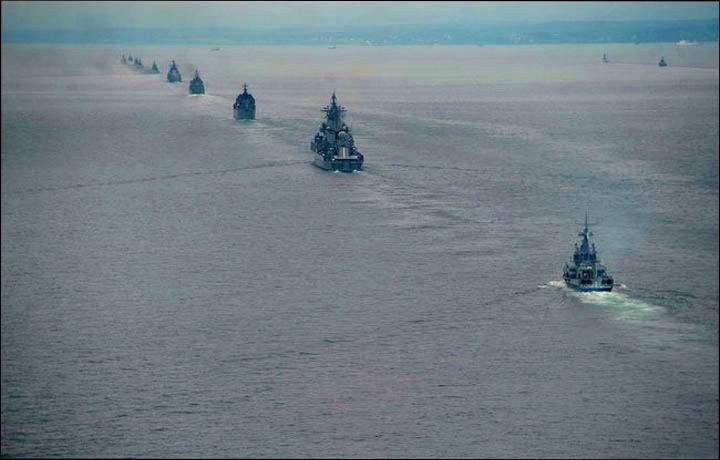
Russian Perspectives on the Strategic Balance in the Asia-Pacific Region
Publication: Eurasia Daily Monitor Volume: 11 Issue: 36
By:

Russian views concerning various global security crises and political revolutions in recent years differ widely from the views of their counterparts in Europe or the United States, ranging from the Arab Spring to recent events in Ukraine. Yet such differences also exist—though by no means marked by equally inflammatory rhetoric—on the security situation in the Asia Pacific Region (APR). In a recent article in Nezavisimoye Voyennoye Obozreniye, Alexei Arbatov, the director of the International Security Center at the Institute of World Economy and International Relations in Moscow, considered strategic relations between China, Russia and the United States and how this triangle impacts on global and regional security—especially in the APR (Nezavisimoye Voyennoye Obozreniye, February 21).
Arbatov covers considerable ground in his article, ranging from the military strengths of these powers, their economic and political relations, as well as some observations on how these ties may develop over the next decade and beyond. However, Arbatov’s starting point is to note that the security environment has deteriorated in the APR over the past two years, before considering the nature of relations within the “big triangle.” In this sense, the author is entirely realistic in highlighting that relations between these three powers are both complex and diverse. Indeed, the military-strategic relations between Beijing, Moscow and Washington are deeply asymmetrical. At its root, the strategic relationship between the US and Russia is about parity in nuclear forces, with a long history of nuclear arms reductions and the new START (START III) agreement in 2010 limiting both sides to 700 deployed delivery vehicles and 1,550 warheads (strategic nuclear forces). By contrast, according to Arbatov, China’s relations with Russia and the US are highly ambiguous and certainly not linked to nuclear parity. The US retains overwhelming nuclear superiority over China, though acknowledging the latter’s right to nuclear deterrence. Arbatov argues that for Washington the center of gravity has shifted in nuclear deterrence toward the APR (Nezavisimoye Voyennoye Obozreniye, February 21).
The author is optimistic that the 2010 START treaty will survive, despite the “disturbing factors” in the form of US behavior; these include Ballistic Missile Defense (BMD) as well as Prompt Global Strike. Arbatov views the current impasse over BMD as reflecting the internal political character in both states, and he concludes that these issues will not change the overall military balance in the next 10 to 15 years. However, returning to his theme of strategic imbalance in Sino-US relations, Arbatov provides evidence for the US shift toward the APR by stressing the presence of 8 out of 14 US ballistic missile submarines (SSBN) being present in the Pacific Ocean. He also asserts that China’s Intercontinental Ballistic Missiles (ICBM) are vulnerable to a US first strike. Turning to Sino-Russian relations, Arbatov characterizes this as much more “vague.” China has around 50 ICBMs that could target Russia’s European territory and three times more that may reach its Far East and Siberia (Nezavisimoye Voyennoye Obozreniye, February 21).
Nonetheless, other Russian analysts see US-Russian relations as having reached their lowest point since the early 1990s; and the reasons or causes are numerous including differences over the Arab Spring and color revolutions, arms reduction, as well as opposing views of the situation in Ukraine. In such analyses, and reflected in official statements, Moscow reserves the right to withdraw from START unless the US “behaves itself” over BMD and Prompt Global Strike, and understands that Russia will not discuss reductions in “tactical nuclear weapons” (https://nvo.ng.ru/realty/2014-02-21/1_snv.html#). The sense of crisis in Russia’s relations with the North Atlantic Treaty Organization was recently highlighted in an official NATO report, offering a bleak outlook for future cooperation. During that roundtable event in Rome, one senior Russian analyst referred to Moscow’s view that small nations cannot be left to make strategic decisions on their own—he then pointed to Ukraine as one such “small nation” (https://www.ndc.nato.int/news/current_news.php?icode=633).
These fissures in Russia-US-NATO relations have a risk of playing out in the APR. Arbatov asserts that the future of US-Russia nuclear arms reductions is tied to the “China factor.” In these terms, China needs to become part of the process. “For example, in exchange for China opening information about its potential and limit strategic weapons and intermediate-and shorter-range missiles, the US will have to stop further expansion of missile defense systems in the Pacific. Of course, this implies the preservation of the USSR-US Treaty on Intermediate-range missiles from 1987.” He adds “The current US missile defense system and [those of Washington’s] allies in the APR are sufficient to deal with a North Korean missile attack. However, this system in the future will not be able to parry the PRC [People’s Republic of China], but will only spur the Chinese nuclear power capacity” (Nezavisimoye Voyennoye Obozreniye, February 21).
Arbatov recognizes that there is no “silver bullet” for Russia in its relations with the APR, and suggests that the country must, in the long term, diversify its relations in this region; but the partners Russia needs are more interested in commerce than politics, and here Arbatov includes the US, Japan, South Korea, Taiwan and Canada. But the security dimension is not far from his thinking: Russia must strengthen its Air Force and Aerospace Defense and Ground Forces vis-à-vis China, as Arbatov states: “Reliable defense will not worsen military relations with China, but will give them stability and predictability” (Nezavisimoye Voyennoye Obozreniye, February 21).
Diversifying Russian strategic interests in the APR is not about acting against China, in the author’s view, but pursuing long-term cooperative arrangements that contribute to regional security. Moscow’s current strategy and focus in the APR contributes to “nodes of tension,” while in Europe there is no direct military implication for Russia’s political-economic issues; this is not so in the APR. Arbatov concludes by saying that the APR has emerged as a “matter of national security, sovereignty and territorial integrity of Russia in the first half of the 21st century” (Nezavisimoye Voyennoye Obozreniye, February 21).
Arbatov’s analysis is of interest to those trying to decipher how Moscow follows and perceives the US “Asia Pivot.” China’s role in this triangle is seen as more opaque, rendering the nature of relations within this triangle of powers impossible to predict. Yet, Russia-NATO relations and arguably US-Russia relations had already reached lows prior to the crisis in Ukraine. At a strategic level, Moscow is continuing to seek ways to challenge US, European Union, and NATO policy in one theatre—Europe—while increasingly its leading analysts and officials understand that the longer term conflicts of interest may lie in the APR.




